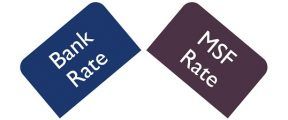 To fulfil the financial requirement of the enterprise, the business person should identify the purpose and term for availing credit, i.e. nothing is better than a loan if the amount is required to fulfil the long-term financial requirement and if the funds are needed to fulfil the working capital requirement, then overdraft is the best option.
To fulfil the financial requirement of the enterprise, the business person should identify the purpose and term for availing credit, i.e. nothing is better than a loan if the amount is required to fulfil the long-term financial requirement and if the funds are needed to fulfil the working capital requirement, then overdraft is the best option.
Finance is the spine of every business because in the absence of sufficient funds the business cannot function properly. From the day, the decision to start a business is taken, the need for finance is realised. It is required to purchase plant and machinery, inventory, office furniture and so on, while some amount is needed for undertaking regular operations.
The capital brought in by proprietor may not be adequate to fulfil all the financial requirements of the company, rather the entrepreneur has to seek different sources. There are many options present before the entrepreneur, to avail finance, and so loan and overdrafts came into the picture.
Take a read of the article to understand the difference between overdraft and loan.
Content: Overdraft Vs Loan
Comparison Chart
| Basis for Comparison | Overdraft | Loan |
|---|---|---|
| Meaning | Overdraft is an arrangement under which the customer is allowed to withdraw in excess of the balance standing as credit in the current account, but only up to a certain limit. | Loan refers to the fixed sum of money borrowed for a definite period, against collateral, which is expected to be repaid with interest. |
| What is it? | Credit facility | Borrowed capital |
| Source of | Short-term funds | Long-term funds |
| Interest | Charged on amount overdrawn. | Charged on loan sanctioned. |
| Calculation of interest | Daily basis | Monthly basis |
| Repayment | Through deposits in the bank account. | Either on demand or on fixed monthly installments. |
| Is it necessary for a person to be the bank account holder to avail this service? | Yes, he/she should have a current account in the respective bank. | No, it is not compulsory. |
Definition of Overdraft
Overdraft is a borrowing facility provided by banks to its current account holders, in which they are allowed to withdraw amount over and above the credit balance in their account. However, the withdrawal can be made only up to a certain amount, i.e. overdraft limit, which depends on the credit rating of the customer and varies from one customer to another.
The overdraft facility allows an individual or entity to withdraw short-term funds, as and when required and repay the same by way of deposits in the account along with interest. Customers can avail this facility by making a written request to the bank for granting it. The facility is sanctioned for one year, after which it has to be renewed. The renewal of the facility is at the discretion of the lending institution, depending upon the satisfactory conduct of the account.
It is somewhat like a revolving loan wherein the customer deposits the amount with the bank for re-borrowing it. Thus the interest is charged on the daily debit balance of the current account. The bank or financial institution has the right to reduce the overdraft limit or cancel the facility anytime. Consequently, the amount due can be called anytime by the bank for repayment without any prior notice to the account holder.
Definition of Loan
The term ‘loan’ is understood as the fixed amount of credit extended by banks, for a specified term, which has to be repaid in future, along with interest as per the stipulated repayment schedule.
It is an agreement between the lender (banking company) and the borrower (customer) in which the lender transfers money to the borrower, for a particular period, which has to be returned along with the interest thereon, in the future. The transfer of funds is made against collateral, such as land, building, vehicle, gold and the like. If the borrower delays payment or defaults in payment, the lender has the right to realise the outstanding amount by selling the security.
The credit record of customer plays an important role in determining, whether the borrower has the capability of repayment or not. So, on the basis of the credit ratings given by the recognised credit rating agencies, the loan amount is sanctioned.
Key Differences Between Overdraft and Loan
The points given below clarifies the difference between overdraft and loan, considering various parameters:
- An arrangement in which the bank customer is permitted to withdraw amount more than the credit balance standing in the current account is called overdraft. The fixed sum of money borrowed for a certain term, against security and is assumed to be repaid with interest in future is called the loan.
- While overdraft is a credit facility provided by the bank to its customers, the loan is the capital borrowed by the customer from the bank.
- Overdraft is a source of short-term finance; that fulfils the working capital requirement of the company. On the other hand, the loan is a means of long-term finance; that helps in acquiring fixed assets like land, building, furniture, etc.
- Interest on overdraft is charged on the amount overdrawn and not on the limit sanctioned, whereas interest on the loan is charged on the whole sum sanctioned.
- Interest on overdraft is calculated on a daily basis, till the amount overdrawn is repaid completely. Conversely, loan interest is computed on a monthly basis, keeping in mind the amount loaned and the term.
- The repayment of overdraft can be made through deposits made in the bank account. As against this, the amount of loan can be repaid, depending on the type of loan, i.e. if it is a demand loan, the sum has to be paid back on demand of the banker, but in the case of time loan, the sum is payable in equated monthly installments (EMI).
- For availing overdraft facility, an individual or entity must have a current account with the respective bank. On the contrary, there is no such pre-condition to be a bank account holder for taking a loan.
Conclusion
In a nutshell, overdraft is a facility that permits an individual to keep on withdrawing the sum from his current account, even if the available balance is zero. On the flip side, the loan is the fund borrowed from the bank against collateral. The rate of interest so imposed on the overdraft is greater than the loan.






RajanChauhan says
Very Informative Blog!!!
I work in the finance industry, still, i didn’t know the difference between these two thanks for sharing your knowledge.
Today, I have learned that for short duration – go for an overdraft – that only for contingency purpose. The loan should be taken to meet my long-term needs.
DHARAMVEER says
I WILL SHARE AN EXAMPLE ,LETS WE HAVE A FIXED DEPOSIT IN BANK OF 3 LAKH RS.
IF WE NEED MONEY AND DO NOT WANT TO BREAK FD ,WE HAVE TWO OPTIONS
1) LOAN AGAINST FD
2)OVERDRAFT AGAINST FD
BANK WILL GIVE US MAX 270000 RS IN BOTH CASES
THE BENEFIT OF OVERDRAFT IS THAT WE WILL HAVE A SEPERATE ACCOUNT IN WHICH INTEREST IS ONLY CALCULATED ON THE AMOUNT WE WITHDRAW.FOR EXAMPLE IF I MAKE AN OVERDRAFT ACCOUNT OF 270000 BUT I ONLY USED 50000 OUT OF IT THEN INTEREST WILL BE CALCULATED ON 50000 ONLY NOT ON WHOLE AMOUNT.
WHEREAS IN CASE OF LOAN WE HAVE TO PAY INTEREST ON WHOLE AMOUNT SANCTIONED.
FactorLoads says
I am in the finance industry. I think that this article will definitely help me to understand the different between overdraft and loan. This article is very helpful!
mojit says
can we take tax benefits on overdraft loan
Lauren says
As a businessman,I think that it is very important that I know the difference between overdraft and loan. This article is very helpful for me to know the difference between overdraft and loan. This will surely help me to avoid issues or problem. Thanks for sharing this article.
WeFactor says
Yes, I totally agree with what you said. I also think that finance is the spine of every business because in the absence of sufficient funds the business cannot function properly. That’s why I also believe that we should our business finances well. Thanks for sharing this article.